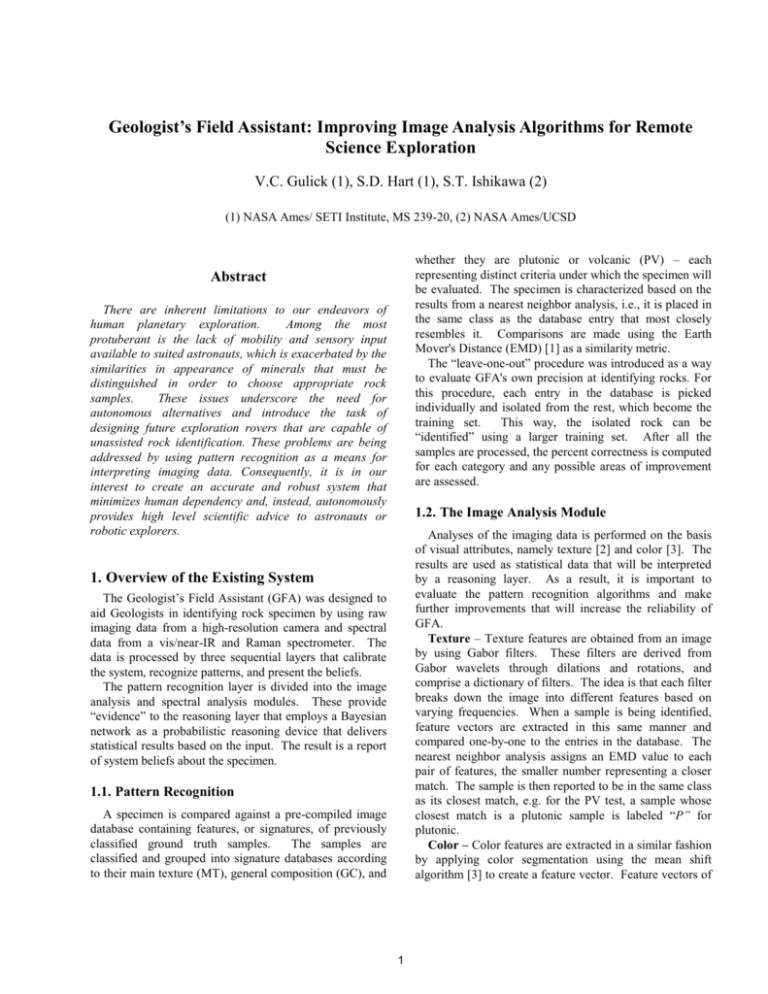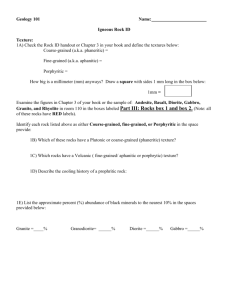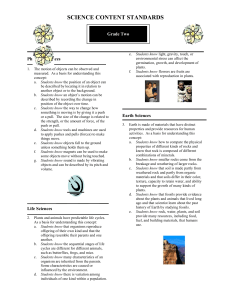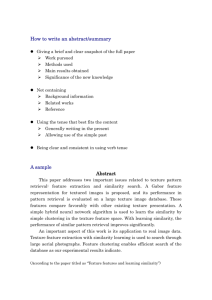proposal
advertisement

Geologist’s Field Assistant: Improving Image Analysis Algorithms for Remote Science Exploration V.C. Gulick (1), S.D. Hart (1), S.T. Ishikawa (2) (1) NASA Ames/ SETI Institute, MS 239-20, (2) NASA Ames/UCSD whether they are plutonic or volcanic (PV) – each representing distinct criteria under which the specimen will be evaluated. The specimen is characterized based on the results from a nearest neighbor analysis, i.e., it is placed in the same class as the database entry that most closely resembles it. Comparisons are made using the Earth Mover's Distance (EMD) [1] as a similarity metric. The “leave-one-out” procedure was introduced as a way to evaluate GFA's own precision at identifying rocks. For this procedure, each entry in the database is picked individually and isolated from the rest, which become the training set. This way, the isolated rock can be “identified” using a larger training set. After all the samples are processed, the percent correctness is computed for each category and any possible areas of improvement are assessed. Abstract There are inherent limitations to our endeavors of human planetary exploration. Among the most protuberant is the lack of mobility and sensory input available to suited astronauts, which is exacerbated by the similarities in appearance of minerals that must be distinguished in order to choose appropriate rock samples. These issues underscore the need for autonomous alternatives and introduce the task of designing future exploration rovers that are capable of unassisted rock identification. These problems are being addressed by using pattern recognition as a means for interpreting imaging data. Consequently, it is in our interest to create an accurate and robust system that minimizes human dependency and, instead, autonomously provides high level scientific advice to astronauts or robotic explorers. 1.2. The Image Analysis Module Analyses of the imaging data is performed on the basis of visual attributes, namely texture [2] and color [3]. The results are used as statistical data that will be interpreted by a reasoning layer. As a result, it is important to evaluate the pattern recognition algorithms and make further improvements that will increase the reliability of GFA. Texture – Texture features are obtained from an image by using Gabor filters. These filters are derived from Gabor wavelets through dilations and rotations, and comprise a dictionary of filters. The idea is that each filter breaks down the image into different features based on varying frequencies. When a sample is being identified, feature vectors are extracted in this same manner and compared one-by-one to the entries in the database. The nearest neighbor analysis assigns an EMD value to each pair of features, the smaller number representing a closer match. The sample is then reported to be in the same class as its closest match, e.g. for the PV test, a sample whose closest match is a plutonic sample is labeled “P” for plutonic. Color – Color features are extracted in a similar fashion by applying color segmentation using the mean shift algorithm [3] to create a feature vector. Feature vectors of 1. Overview of the Existing System The Geologist’s Field Assistant (GFA) was designed to aid Geologists in identifying rock specimen by using raw imaging data from a high-resolution camera and spectral data from a vis/near-IR and Raman spectrometer. The data is processed by three sequential layers that calibrate the system, recognize patterns, and present the beliefs. The pattern recognition layer is divided into the image analysis and spectral analysis modules. These provide “evidence” to the reasoning layer that employs a Bayesian network as a probabilistic reasoning device that delivers statistical results based on the input. The result is a report of system beliefs about the specimen. 1.1. Pattern Recognition A specimen is compared against a pre-compiled image database containing features, or signatures, of previously classified ground truth samples. The samples are classified and grouped into signature databases according to their main texture (MT), general composition (GC), and 1 unknown samples are once again compared to a color signature database using the nearest neighbor method and the closest matches are determined. 2.1. Discussion The general trend seems to indicate that the accuracy improves as the database grows in number. This implies that there are unique traits specific to each class that are being recognized in individual rocks. Out of 173 samples labeled by geologists as ground truth phaneritic, 83% of the samples were correctly identified using the training sets (Table 2). Aphanitic samples, on the other hand, were almost half in number and had a much lower correctness rate (38%). This suggests that simply collecting more rock specimen will make GFA more accurate. Note, too, that the probability of incorrectly classifying aphanitic samples as phaneritic (and vice versa) is significantly low. This is because the porphyritic samples act as a buffer, since they contain the characteristics of both aphanitic and phaneritic samples. While determining the best values for these parameters, it becomes increasingly important to have a way of visualizing these filers and their effects on the images they are being applied to. This will provide a more qualitative understanding as to what the filters are doing and whether or not they are effectively extracting unique features. We can then fine-tune these parameters accordingly in an attempt to calibrate the code and optimize our results. 2. Results Correctness results for texture analysis have varied by adjusting the number of scales and orientations in the filters, as well as reducing the image resolution. This suggests that there is a need to optimize these parameters in order to produce the best possible results. Texture results were evaluated using the leave-one-out method described in Section 1.1. A database of roughly 400 2048 x 1536 pixel rock images was used with a reduction factor of 4 on each image. Results for PV test, based on percent correctness, are displayed in Table 1. Correct Total % Correctness Plutonic 153 179 85.4749 Volcanic 175 205 85.3659 Table 1. Texture results using Gabor filters at 3 scales/6 orientations GFA was able to distinguish between plutonic (generally fine-grained) and volcanic (generally coarsegrained) about 85% of the time using Gabor filters set to 3 scales and 6 orientations (Table 1). Tests were also conducted on main texture (MT), which is categorized into three main types: aphanitic (fine-grained), porphyritic (fine-grained with scattered crystals), and phaneritic (coarse-grained). These results, using Gabor filters set at 5 scales and 10 orientations, are displayed in Table 2. The shaded boxes indicate the number of samples that were correctly identified under their respective category, i.e., a total of 95 aphanitic samples were tested using the leaveone-out method, 36 of which were correctly identified. The remainder were incorrectly identified as porphyritic (46) and phaneritic (13). Aphanitic Porphyritic Phaneritic Aphanitic 36 37 8 Porphyritic 46 55 21 Phaneritic 13 26 144 Total 95 118 173 3. Improvement of GFA GFA is based on a probabilistic reasoning system in which evidence is presented and processed according to geological rules that have been coded into the system. As a result, every piece of evidence – be it the presence of the mineral pyroxene or large pink-colored crystals commonly found in granite – greatly helps to narrow down the possibilities. This calls for the implementation of more functions that enhance GFA’s ability to detect these singularities. One function that has yet to be implemented is the detection of individual crystals within the rock images. This can be accomplished by designing specific texons that represent features such as porphyries, vesicles (cavities) and crystals – or any other particular arrangement in rocks that are unique to a specific rock type – and specifically look for them in an image. Ideally, the system would be competent enough to recognize these singularities. The introduction of a lightness scale should also be considered since the general composition of a specimen is highly correlated with how light/dark it is. This may be able to push some hard classifications into the correct direction. Since mafics are generally darker than felsics, a sample that was falsely identified as mafic could have a second chance if it had a higher lightness rating taken into account (presumably because lighter rocks tend to be felsic in composition). This could potentially be the deciding factor for cases of multiple close-match queries; however, % Correct 37.8947 46.6102 83.237 Table 2 - Texture results using Gabor filters at 5 scales/10 orientations 2 before this is implemented, experiments should be conducted to see how given rock attributes are related to their lightness. Another insight is to introduce a way of weighting highresolution pattern recognition results with lowerresolutions ones and have a decision tree structure that decides on what signature databases to use based on types of rocks. Experiments have suggested that the color analysis results using mean shift clustering tend to be more accurate at lower resolutions. The opposite seems to true for Gabor wavelet analysis of texture. References [1] Y. Rubner, C. Tomasi, and L.J Guibas. “The Earth Mover’s Distance as a Metric for Image Retrieval,” IEEE Conf. on Computer Vision. Bombay, India. 1998. [2] B.S. Manjunath and W.Y. Ma. “Texture Features for Browsing and Retrieval of Image Data,” IEEE Transactions on Pattern Analysis and Machine Intelligence, Vol. 18, No. 8:837–842, 1996. [3] D. Comaniciu, P. Meer. “Robust Analysis of Feature Spaces: Color Image Segmentation,” cvpr, p.750, 1997 IEEE Computer Society Conference on Computer Vision and Pattern Recognition (CVPR’97), 1997. 3 List of Qualifications Milestones and Deadlines Dates: June 2003 – August 2003 Location: NASA Ames Research Center Job Description: Programmer & Field Assistant Duties/Responsibilities: Help create a graphical display of telemetry data for “K-9” mars rover prototype. Assist in field tests conducted at the “Marscape.” Week 1-3: Begin designing a system to (visually) identify specific minerals in sample images. Develop a parameter field showing correctness rates as a function of the 1) number of scales, 2) orientations, and 3) resolution reduction factor. Note: Feature extraction takes up to several days since the database contains hundreds of highresolution images. Week 3-5: Implementation of mineral detector function. Week 5-6: Show preliminary results (using only a few training samples) to see how correctness rate is affected. Week 6-8: Design and implement lightness scale. Week 9-10: Report results using full database. Begin writing report (draft). March 6: Experiments and final report complete. Dates: June 2004 – December 2004 Location: NASA Ames Research Center Job Description: Programmer Duties/Responsibilities: Update the Geologist’s Field Assistant (GFA) system that identifies unknown rock samples via color and texture analysis. Work with geologists to organize and benchmark various implementations of algorithms and report the results. Dates: July 2005 – Present Location: NASA Ames Research Center Job Description: Programmer Duties/Responsibilities: 1. Fix memory issues associated with highresolution texture analysis. 2. Perform test runs of “unknown” rock samples and evaluate correctness. 3. Assess strengths and weaknesses of current algorithms. 4. Use compression algorithms and demonstrate their efficiency on images obtained by the 2005 Mars Exploration Rovers (MER) mission. 4







